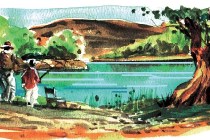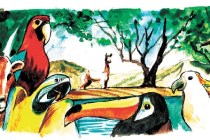In summer and fall, the high country east of Cedar City, Utah, easily accessible for Southern Nevadans, offers cooler temperatures, splendid scenery and ample outdoor recreation opportunities.
Trip of the Week
Margo Bartlett Pesek writes about day trips from Las Vegas and information about the surrounding areas. Her column appears Sunday in Travel/Living.
Summer and fall are brief but glorious seasons in Southern Utah’s high country, where snow blankets the forests nearly half of the year. Cedar Breaks National Monument, located atop a 10,600-foot plateau, draws more than a half-million visitors during the few months a year that it is open.
One of the prettiest side roads in Nevada, the Success Summit Loop near Ely packs a lot of scenery into 38 miles. The route climbs over a high forested summit after leaving U.S. Highway 93 either north or south of Ely and remains open from snowmelt to snowfall, usually from April through mid-November.
The Hualapai Mountains, just 14 miles from the desert city of Kingman, Ariz., provide opportunities for year-round recreation.
Independence Day weekend brings a unique double celebration to Elko.
In Nevada, where it’s been dubbed the Great Basin Highway, scenic U.S. Highway 93 runs from the Arizona border to the Idaho border, along the way accessing historic towns, several state parks, hundreds of miles of off-highway vehicle trails and numerous opportunities for outdoor recreation.
Side roads exploring Southern Utah offer a lot of scenery, history and recreation potential without the crowds typically found at the area’s major attractions.
Everybody enjoys getting a freebie now and then. You can save a few dollars on recreation on the days when state and national parks waive their entrance fees or states offer free fishing.
Southern Utah’s dramatic geological features and vividly colored sandstone formations invite visitors to explore and take a closer look.
In Nevada’s arid southern tip, few places exist where one can hear the murmur of a running stream.
Springtime retreats into the hills and rugged mountains this month in the Mojave National Preserve south of Las Vegas near the Nevada-California border.
Nevada’s largest, oldest and most spectacular state park, Valley of Fire lives up to its name with its eroded sandstone formations and sand dunes in fiery shades of red. Changing constantly with the angle of the sun, the colors range from the brilliance of leaping flames to the glowing hues of hot embers.
A historic ranch lies at the heart of Floyd Lamb Park at Tule Springs, a spacious city recreational facility at the edge of northwest Las Vegas.
Despite the ever-expanding urban development in the Las Vegas Valley, remnants of the area’s rural past live on in a few places such as the Gilcrease Nature Sanctuary, Gilcrease Orchard and the nearby city park at Tule Springs.
Thousands of miles of track once connected Nevada towns with the transcontinental railroads. From territorial days to modern times, at least 70 railroads operated in the state, both standard and narrow gauge. Built to move ore from mines to mills, the lines also carried freight and passengers.















